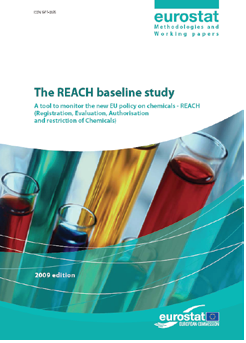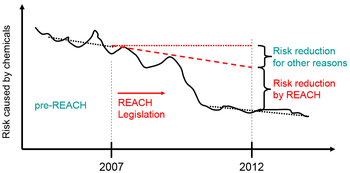Archive:Chemicals - monitoring REACH with indicators
- Data from July 2010, most recent data: Further Eurostat information, Main tables and Database.
Since June 2007, REACH, the European Union 'Regulation on the Registration, Evaluation, Authorisation and restriction of Chemicals', is in force. The major objective of REACH is to ensure a high level of protection for human health and the environment, by increasing knowledge about the hazardous properties of chemicals.
Eurostat has developed a baseline study, providing a set of indicators that will monitor the effectiveness of REACH.
This article explains the main statistics used and the indicators developed, illustrated by tables and graphs.
Main statistical findings
Previous work carried out by Eurostat in the field dates back to the period from the mid-1990s to 2000 when some Environmental Pressure Indicators (EPI) related to chemicals were developed. One of the recent priorities of Eurostat has been the development of indicators on toxic and environmentally harmful chemicals in order to be able to measure progress towards the headline objective for ‘public health’ established in the EU - Sustainable Development Strategy and the 6th EU Environment Action Programme.
The European Commission and scientific experts expressed the need for developing a baseline before REACH came into force, and an instrument to monitor the effectiveness of REACH. To do so Eurostat proposed the development of a set of risk-based (and not damage-based) indicators.
A REACH Baseline Study with the aim of setting the baseline 2007 of the potential risk for consumers, workers, and the environment was carried out. With the developed methodology, the calculations of the potential risks will be repeated for the 5-year assessment of REACH due in June 2012.
Text with Footnote [1]
Subdivision 1
Subdivision 2
Data sources and availability
<description of data sources, survey and data availability (completeness, recency) and limitations>
Context
<context of data collection and statistical results: policy background, uses of data, …>
Further Eurostat information
Publications
Tables
- Title(s) of second level folder (if any)
- Title(s) of third level folder (if any)
Database
- Title(s) of second level folder (if any)
- Title(s) of third level folder (if any)
Dedicated section
Source data for tables and graphs on this page (MS Excel)
Other information
<Regulations and other legal texts, communications from the Commission, administrative notes, Policy documents, …>
- Regulation 1737/2005 of DD Month YYYY on ...
- Council Directive 86/2003 of DD Month YYYY
- Commission Decision 86/2003 of DD Month YYYY
<For other documents such as Commission Proposals or Reports, see EUR-Lex search by natural number>
<For linking to database table, otherwise remove: {{{title}}} ({{{code}}})>
External links
See also
Notes
- ↑ Text of the footnote.
[[Category:<Category name(s)>]] [[Category:<Statistical article>]]


